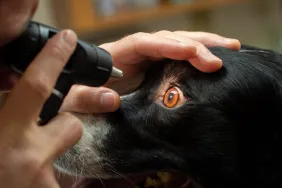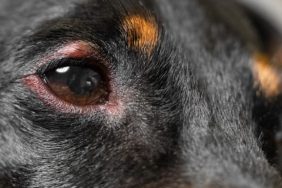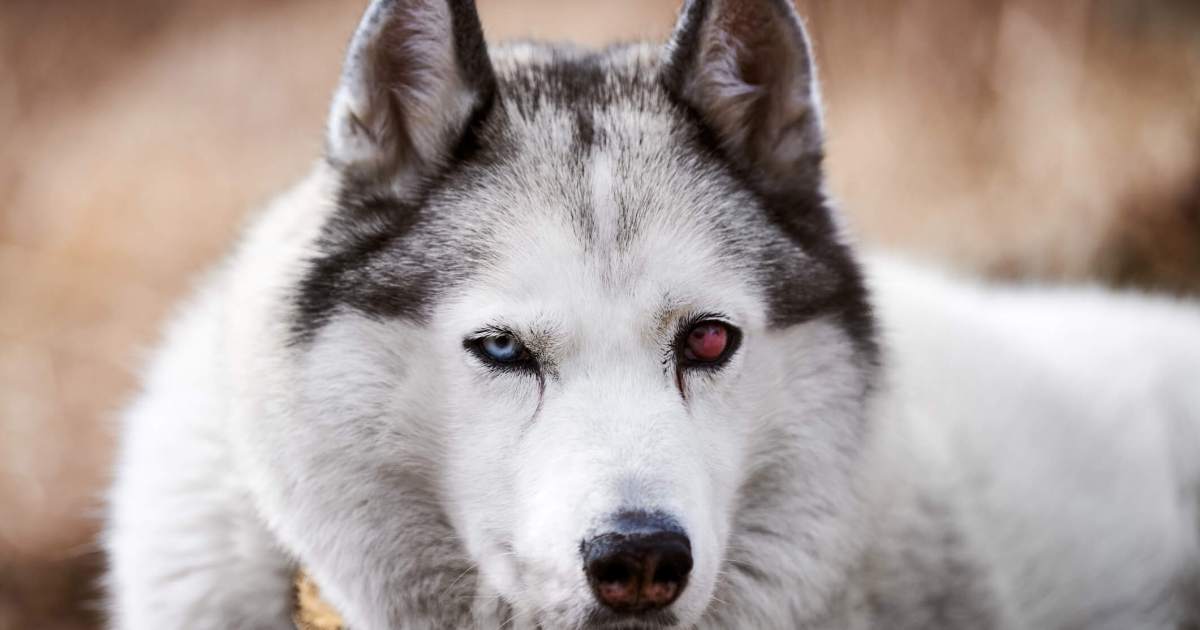Scleritis in canines is an inflammatory scenario affecting the sclera — the white outer layer of the eyeball. The sclera is a dense, fibrous tissue that offers structural help and security to the eye. When this tissue turns into contaminated, it might presumably set off redness, swelling, and discomfort in affected canines. Whereas it is a lot much less frequent than one other ocular illnesses, scleritis might be excessive and doubtlessly vision-threatening.
Proper right here’s what it’s best to know regarding the indicators, causes, and coverings for the sickness in canines.
Indicators of scleritis in canines

The most common indicators of scleritis in canines are:
- Redness and swelling
- Ache
- Tearing and discharge
- Color modifications
- Imaginative and prescient points
- Behavioral modifications
Scleritis might be broadly categorized into two foremost varieties: anterior scleritis and posterior scleritis. All kinds is extra categorised based mostly totally on specific traits and manifestations.
- Anterior scleritis: Anterior scleritis contains irritation of the doorway part of the sclera. This sort is further frequent and is usually less complicated to diagnose on account of its seen indicators.
- Posterior scleritis: Posterior scleritis impacts the once more part of the sclera. The irritation can lengthen to the buildings inside the attention, leading to further extreme issues. This sort is more durable to diagnose on account of its location and the subtler medical indicators.
You will have to note that whereas scleritis primarily impacts the deeper layers of the sclera, there are related conditions that differ significantly in severity and affect, resembling necrotizing scleritis and episcleritis. Necrotizing scleritis is a really excessive kind of scleritis, characterised by intense irritation that leads to tissue necrosis — or, put in any other case, tissue lack of life. This case is extreme and requires speedy, aggressive treatment to avoid excessive issues. In distinction, episcleritis is a separate and much milder scenario, involving irritation of the episclera — the thin layer of tissue between the sclera and the conjunctiva.
Causes of scleritis in canines
Scleritis in canines can come up from assorted underlying factors, and determining the muse set off is essential for environment friendly treatment. The potential causes embody:
- Immune-mediated conditions: Autoimmune issues are a normal cause for scleritis in canines. These conditions set off the physique’s immune system to mistakenly assault its private tissues, along with the sclera.
- Infections: Bacterial, viral, fungal, or parasitic infections can invade the sclera and lead to irritation. Frequent pathogens embody Staphylococcus, Streptococcus, and Aspergillus species.
- Trauma: Bodily harm to the eye — whether or not or not from an accident, battle, or abroad object — can damage the sclera and finish in irritation.
- Systemic illnesses: Positive systemic illnesses — resembling Lyme sickness, ehrlichiosis, and systemic lupus erythematosus — can have ocular manifestations, along with scleritis.
- Neoplasia: Tumors, every benign and malignant, can infiltrate the sclera and set off irritation.
- Idiopathic: In some circumstances, the exact cause for scleritis is not going to be acknowledged, and it is then termed idiopathic.
As regards to diagnosing scleritis in your canine, it’s essential to hunt the recommendation of a veterinarian who can perform an entire eye examination. This examination normally contains a detailed take a look at your canine’s medical historic previous, along with specific exams to guage eye properly being. Your vet could use devices like an ophthalmoscope to look at the inside buildings of the eye or a slit lamp to get a extra in-depth take a look on the cornea and sclera. Furthermore, they might perform a Schirmer tear check out to confirm tear manufacturing and fluorescein staining to find out any corneal ulcers.
Sometimes, diagnosing scleritis might be robust, as its indicators can mimic totally different eye conditions. Subsequently, your veterinarian might recommend additional exams resembling blood work, cultures, and even imaging analysis like an ultrasound or MRI to rule out totally different underlying factors. If an immune-mediated scenario is suspected, they might moreover suggest a biopsy.
Treatments for scleritis in canines

Treatment for scleritis in canines relies upon upon the underlying set off and the severity of the scenario. Some therapeutic approaches embody:
- Corticosteroids: Corticosteroids are typically the first line of treatment for scleritis. You could administer these anti-inflammatory medicines as eye drops, oral tablets, or injections, counting on the severity of the scenario. Prednisone and dexamethasone are typically used corticosteroids in veterinary treatment.
- Nonsteroidal anti-inflammatory medication (NSAIDs): For canines who cannot tolerate corticosteroids or in circumstances the place additional anti-inflammatory administration is required, NSAIDs resembling carprofen or meloxicam is also prescribed.
- Immunosuppressive brokers: In circumstances the place scleritis is immune-mediated or does not reply to corticosteroids and NSAIDs, stronger immunosuppressive medication like cyclosporine or azathioprine is also compulsory. These medicines help suppress the immune system’s irregular response, lowering irritation.
- Topical medicines: Furthermore systemic therapies, topical medicines can current direct discount to the affected eye. Your vet might recommend antibiotic or antifungal eye drops or artificial tears to maintain up eye moisture and luxurious.
In a number of circumstances, if scleritis is acknowledged early and dealt with aggressively, the prognosis might be pretty favorable. However, if left untreated or if the underlying set off is a further excessive systemic problem, the prognosis is also further guarded, doubtlessly leading to issues resembling imaginative and prescient loss or the unfold of irritation to totally different elements of the eye. It’s vital to work rigorously collectively along with your veterinarian or a veterinary ophthalmologist to look at your canine’s response to treatment and regulate the care plan as needed. As such, widespread follow-ups and adhering to the prescribed treatment routine are crucial for attaining the very best remaining lead to your pet.
Additional on canine imaginative and prescient:

Retinal dysplasia in canines is a watch dysfunction that is characterised by the irregular development of the retina all through fetal…

Retinal degeneration in canines is a medical scenario that causes factors with the way in which during which a canine sees and will even…

Eye accidents in canines happen when the cornea or sclera is penetrated, normally by a trauma. Subsequently, the harm can…

These questioning “Can canines see at midnight?” and whether or not or not they’ve “night time time imaginative and prescient” will uncover the need-to-know data in…
